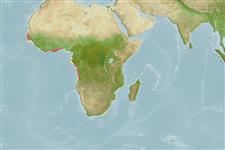>
Gobiiformes (Gobies) >
Gobiidae (Gobies) > Gobiinae
Etymology: Thorogobius: Greek, thoros = semen + Latin, gobius = gudgeon (Ref. 45335); alvheimi: Named for Oddgeir Alvheim of the Institute of Marine Research, Bergen, Norway..
Environment: milieu / climate zone / depth range / distribution range
Ecologie
marien; diepte 74 - 208 m (Ref. 118185). Deep-water
Verspreiding
Landen | FAO regio's | Ecosystemen | Voorkomen | Point map | Introducties | Faunafri
Eastern Atlantic: Angola and Ghana.
Grootte / Gewicht / Leeftijd
Maturity: Lm ? range ? - ? cm
Max length : 10.2 cm SL mannelijk / geslacht onbekend; (Ref. 118185); 7.2 cm SL (female)
Korte beschrijving
Determinatiesleutels | Morfologie | Morfometrie
Dorsale stekels (totaal) : 7; Dorsale zachte stralen (totaal) : 11; Anale stekels: 1; Anale zachte stralen: 10; Wervels: 28. This species is distinguished from its congeners by the following characters: D1 VI (second and third distinctly elongated), D2 I,11; pectoral fin rays 20-21; complete pelvic disc with short with well-developed anterior membrane (frenum), lateral lobes pointed; nape and predorsal area naked; no scales on the opercle; scales in longitudinal series 27-31; supratemporal rows tr and trp developed and extending transversally between pores H and K; longitudinal row g is short, not passing row m posteriorly and distinctly distant from row h; long infraorbital row 6, ventrally extending to lower margin of preopercle, its ventral section 6i originating anterior to its dorsal section 6s; posterior lateral row h reaching anteriorly above posterior third of opercle; body depth 16.6-20.4% at anal-fin origin in SL; head width 42.9-53.8% in head length; upper jaw long 42.6-45.7% in head length; minimum height of caudal peduncle 34.8-50.2% in caudal peduncle length; large eyes 22.4-31.3% in head length; short caudal fin 27.1-32.3% in SL; body is uniformly pale fawn and brown with margin of scale pockets dark brown pigmented, yielding a reticulated pattern; presence of pale spots on nape and predorsal area; caudal fin is uniformly dusky greyish (Ref. 118185).
Specimens were dredged on the outer edge of the continental shelf and found on soft bottom (Ref. 118185).
Levenscyclus en paargedrag
Maturities | Voortplanting | Spawnings | Egg(s) | Fecundities | Larven
Sauberer, M., T. Iwamoto and H. Ahnelt, 2018. Two new deep-water species of the genus Thorogobius (Teleostei: Gobiidae) from the upper continental slope of the Eastern Central Atlantic. Zootaxa 4429(2):357-371. (Ref. 118185)
Status op de Rode Lijst van het IUCN (Ref. 130435)
Gevaar voor de mens
Harmless
Gebruik door de mens
Tools
Speciale rapporten
Download XML
Internetbronnen
Estimates based on models
Fylogenetische diversiteitsindex (Ref.
82804): PD
50 = 0.5156 [Uniqueness, from 0.5 = low to 2.0 = high].
Bayesian length-weight: a=0.00708 (0.00333 - 0.01504), b=3.09 (2.92 - 3.26), in cm total length, based on LWR estimates for this (Sub)family-body shape (Ref.
93245).
Trofisch niveau (Ref.
69278): 3.4 ±0.4 se; based on size and trophs of closest relatives
Weerstandsvermogen (Ref.
120179): Hoog, minimale populatieverdubbelingstijd minder dan 15 maanden (Preliminary K or Fecundity.).
Fishing Vulnerability (Ref.
59153): Low vulnerability (10 of 100).
